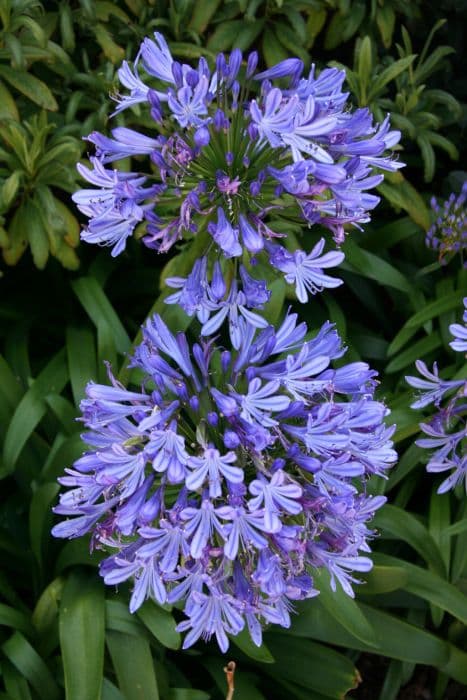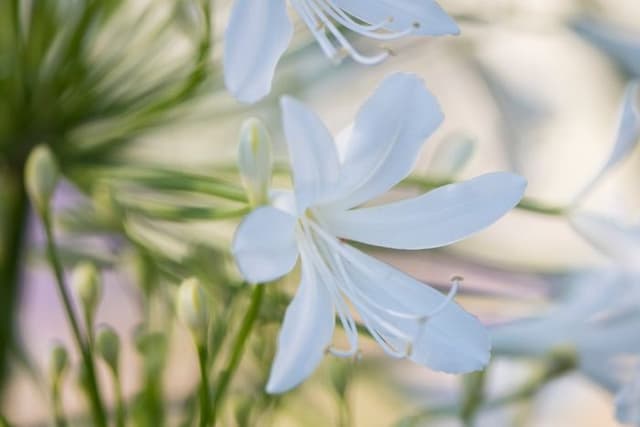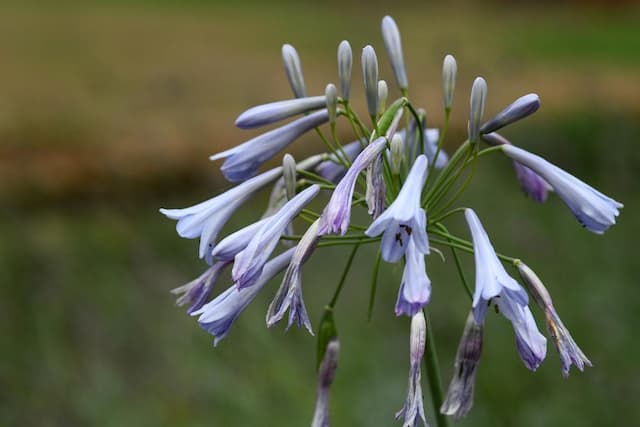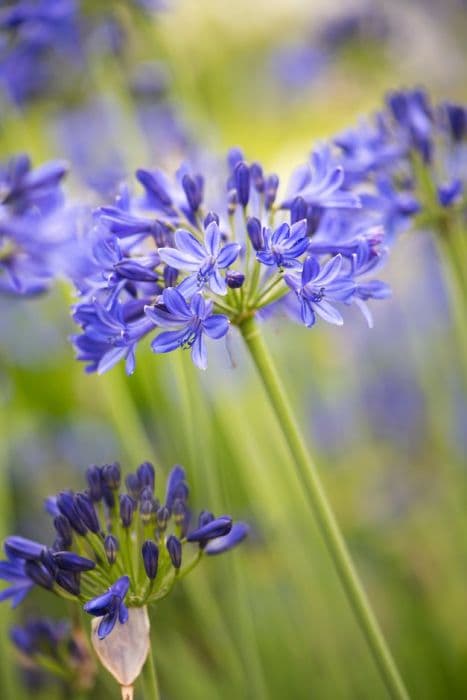Lily of the Nile Agapanthus 'Megan's Mauve'

ABOUT
Agapanthus 'Megan's Mauve' is a graceful ornamental plant known for its striking flowers and lush foliage. The name 'Megan's Mauve' hints at the unique color of its blooms, which are a soft, mauve hue. The flowers are shaped like trumpets, clustered together atop sturdy, upright stems, forming rounded globes or umbels that stand out elegantly against the green backdrop of the garden. The individual blooms are numerous and form a dense spherical cluster, giving the appearance of a single large flower head. The foliage consists of glossy, strap-like leaves that are a bold green color, creating a lush base for the flower stalks. The leaves arch gracefully from the base, creating a rich contrast in texture and color with the delicate flower clusters. Overall, the appearance of Agapanthus 'Megan's Mauve' combines architectural structure with soft color accents, making it a popular choice for gardeners looking for a touch of elegance and a splash of subtle color in their outdoor spaces.
About this plant
 Names
NamesFamily
Amaryllidaceae
Synonyms
African Lily, Lily of the Nile, Love Flower
Common names
Agapanthus 'Megan's Mauve'.
 Toxicity
ToxicityTo humans
Lily of the Nile is known to have toxic properties when ingested. All parts of the plant contain substances that can potentially cause harm if consumed. Symptoms of poisoning from Lily of the Nile can include nausea, vomiting, and diarrhea. The sap may also cause skin irritation or allergic reactions in some individuals. It is important to handle the plant with care and ensure that it is not ingested, especially by children.
To pets
Lily of the Nile is toxic to pets such as dogs and cats. If ingested, the toxic components within the plant can cause symptoms such as vomiting, diarrhea, abdominal pain, salivation, lethargy, and in severe cases, tremors or cardiac problems. It is critical to prevent pets from chewing on or ingesting any part of the plant, and to seek veterinary attention immediately if you suspect your pet has consumed Lily of the Nile.
 Characteristics
CharacteristicsLife cycle
Perennials
Foliage type
Evergreen
Color of leaves
Green
Flower color
Mauve
Height
2-3 feet (0.6-0.9 meters)
Spread
2 feet (0.6 meters)
Plant type
Bulb
Hardiness zones
8
Native area
South Africa
Benefits
 General Benefits
General Benefits- Aesthetic Appeal: Agapanthus 'Megan's Mauve', commonly known as Lily of the Nile, typically bears beautiful mauve flowers that add color and visual interest to gardens.
- Drought Tolerance: Once established, Lily of the Nile is relatively drought-tolerant, making it suitable for xeriscaping and in regions with water restrictions.
- Low Maintenance: It requires minimal care beyond occasional watering and feeding, making it an excellent choice for both novice and experienced gardeners.
- Long Blooming Period: Lily of the Nile has a long flowering season, usually blooming from early summer to fall, providing a consistent display of color.
- Attracts Pollinators: The flowers attract bees, butterflies, and other pollinators, which are beneficial to the ecosystem of a garden.
- Border and Container Planting: This plant is versatile and can be used in mixed borders or as a standalone in containers, adding structure to garden designs.
- Coastal Garden Suitability: Lily of the Nile is suitable for coastal gardens as it can tolerate salty winds and sprays, which is beneficial near ocean settings.
- Deer Resistance: The plant is often resistant to deer, which helps prevent it from being eaten in areas where deer are common.
 Medical Properties
Medical PropertiesThis plant is not used for medical purposes.
 Air-purifying Qualities
Air-purifying QualitiesThis plant is not specifically known for air purifying qualities.
 Other Uses
Other Uses- Artistic Inspiration: Artists and photographers often use the striking blooms of Agapanthus as a subject in their work, drawing inspiration from the plant's vibrant colors and shapes.
- Dye Production: The flowers of Agapanthus can be used to create a mauve or blue dye for textiles, offering a natural coloring option for fabrics.
- Educational Tool: Horticulture educators sometimes use Agapanthus to demonstrate plant growth, hybridization, and care in gardening classes or workshops.
- Ecological Studies: The Agapanthus can be a subject of study for its adaptability and response to environmental conditions, which is useful for research in ecology and climate change.
- Event Decoration: With their showy blooms, Agapanthus can be used to adorn event spaces for weddings, parties, and other celebrations, providing a natural and elegant touch.
- Culinary Garnish: Though not widely recognized for culinary uses, the blossoms of some Agapanthus species may be used as an ornamental garnish for specialty dishes.
- Photography Contests: The unique appearance of Agapanthus can be a feature in photography contests, challenging participants to capture its beauty.
- Bee and Butterfly Garden Inclusion: Agapanthus is a popular choice for gardens designed to attract pollinators like bees and butterflies, making it an asset for biodiversity.
- Stormwater Management: Planted in rain gardens, Agapanthus can help absorb runoff, reduce erosion, and filter pollutants due to its robust root system.
- Ink Production: The pigments from Agapanthus flowers may be used to create botanical inks for artists and crafters looking for natural dye sources.
Interesting Facts
 Feng Shui
Feng ShuiThe Lily of the Nile is not used in Feng Shui practice.
 Zodiac Sign Compitability
Zodiac Sign CompitabilityThe Lily of the Nile is not used in astrology practice.
 Plant Symbolism
Plant Symbolism- Love Letters: Agapanthus, also commonly known as African Lily or Lily of the Nile, often symbolizes love letters or love messages, as its name derives from the Greek words 'agape' (love) and 'anthos' (flower).
- Beauty: With its striking mauve blossoms, African Lily is frequently associated with beauty and the admiration of it, suggesting how people are captivated by its appearance.
- Conveyance of Beauty and Elegance: The stately nature of the Agapanthus lends itself to symbolize the conveyance of beauty and elegance in the language of flowers.
- Enduring Love: The robustness and perennial nature of the African Lily represent enduring or lasting love that can withstand the obstacles of time.
- Home: Often considered a symbol of home or the hearth due to its use in domestic gardens, African Lily may reflect stability and comfort associated with one’s home life.
 Water
WaterAfrican Lily 'Megan's Mauve' should be watered deeply to encourage a strong root system, typically receiving about 1 inch of water once a week, although this may vary depending on climate conditions. During the growing season in spring and summer, it's essential to keep the soil consistently moist, but not waterlogged. If temperatures are very hot or it’s planted in containers, the frequency of watering may need to increase. In the winter, reduce watering as the plant goes dormant, especially in colder climates, to approximately half a gallon every two weeks to prevent root rot.
 Light
LightAfrican Lily 'Megan's Mauve' thrives best in full sun to partial shade. It should be placed in a location where it can receive at least 6 hours of sunlight each day. A spot that gets morning sun and dappled afternoon shade is ideal, especially in regions with very hot summers, to prevent leaf scorch.
 Temperature
TemperatureAfrican Lily 'Megan's Mauve' prefers temperate climates with temperatures ranging between 50 to 80 degrees Fahrenheit. It can tolerate a brief period of colder weather down to 30 degrees Fahrenheit but should be protected from frost. Ideally, keep it in an environment where temperatures don’t drop below 40 degrees Fahrenheit to ensure healthy growth.
 Pruning
PruningPrune African Lily 'Megan's Mauve' to remove spent flower stalks and encourage a second bloom. Pruning should be done after the first flush of flowers has faded, typically in mid-summer. Additionally, cut back the foliage to the ground in late fall or early winter after it dies back, to keep the plant tidy and healthy. This annual pruning will help promote vigorous growth the following season.
 Cleaning
CleaningAs needed
 Soil
SoilAfrican Lily 'Megan's Mauve' thrives in loamy, well-draining soil enriched with organic matter. A mix of two parts loam, one part peat or compost, and one part sharp sand or perlite creates an ideal environment. The soil should have a pH between 6.0 and 8.0, slightly acidic to slightly alkaline for optimal growth.
 Repotting
RepottingAfrican Lily 'Megan's Mauve' should be repotted every 2-3 years or when it becomes root-bound. They can tolerate being slightly root-bound, so repotting isn't needed frequently unless the plant shows signs of distress due to limited space.
 Humidity & Misting
Humidity & MistingAfrican Lily 'Megan's Mauve' prefers moderate humidity levels but is quite adaptable. Aim for humidity levels between 40% and 60% for optimal growth. Avoid environments that are too arid or excessively humid to maintain plant health.
 Suitable locations
Suitable locationsIndoor
Place Lily of the Nile in bright, indirect light, and keep soil moderately moist.
Outdoor
Full sun to partial shade and well-draining soil for optimal Lily of the Nile growth.
Hardiness zone
7-11 USDA
 Life cycle
Life cycleAgapanthus 'Megan's Mauve', commonly known as Lily of the Nile, begins its life cycle as a seed which germinates to form a small seedling. The seedling then develops into a vegetative plant with strap-like leaves, becoming more robust through the accumulation of energy via photosynthesis. As it matures, the plant enters a flowering phase, usually during the summer months, where it produces tall stalks topped with globular clusters of mauve flowers. Once the flowering period is over, seeds develop within the spent flower heads if pollination has occurred. These seeds can then be dispersed to begin a new generation. Finally, during the dormant season, typically in winter, the plant's above-ground parts may die back, but the rhizomes or roots will remain alive, ready to regenerate for the next growing season.
 Propogation
PropogationPropogation time
Spring-Early Summer
Propogation: Agapanthus 'Megan's Mauve', commonly referred to as Lily of the Nile, is often propagated by division, which is best done in the spring or early fall when the plant is not in active growth. This common method involves gently separating the plant's clump into smaller sections, each with a portion of the root system. It's important to use a sharp, clean knife or spade to slice through the fleshy roots, ensuring that each division has at least one or two healthy growing points. Once divided, the sections can be immediately replanted in well-draining soil, spaced appropriately to allow for future growth, and watered thoroughly to establish them in their new locations. Dividing the plant not only propagates new lilies but also invigorates the parent plant by reducing overcrowding.









